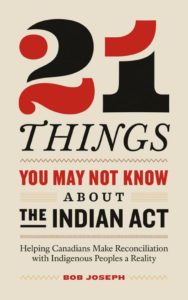Book Review: 21 Things You May Not Know About the Indian Act
 By Christine Miskonoodinkwe Smith
By Christine Miskonoodinkwe Smith
In “21 Things You May Not Know About the Indian Act: Helping Canadians Make Reconciliation with Indigenous Peoples a Reality,” the author Bob Joseph endeavors to provide insight into 21 rules, regulations and prohibitions of the Indian Act. He writes about some of the paternalistic rules and regulations of the Indian Act and how they have led and continue to lead into stereotypes and myths about Indigenous peoples to this day.
Since its creation in 1876, the Indian Act has governed Indigenous peoples of Canada. It has largely been a policy that has been paternalistic and geared towards the assimilation of Indigenous peoples as a whole. According to Joseph:
“The roots of the Indian Act lie in the Bagot Report of 1844 that recommended that control over Indian matters be centralized, that the children be sent to boarding schools away from the influence of their communities and culture, that the Indians be encouraged to assume the European concept of free enterprise, and that land be individually owned under an Indian land registry system in which they could sell to each other but not to non-Indians. The Bagot Report provided the framework for the Indian Act, 1876.”
The paternalistic attitude that came from the governance of the Indian Act gave way to punitive rules, prohibitions and regulations that dehumanized Indigenous people, and led to many stereotypes that non-Indigenous people came to believe as factual. One stereotype was how Indigenous peoples governed themselves before European contact. Indigenous nations had their own distinctive political institutions, traditions, leadership system, culture, and economy. They also had autonomous control over their territories and the resources within. It was when European style elections for Chief and Council were introduced in 1869, that the imposed system did not honour Indigenous forms of government and displaced traditional political structures and did not reflect, consider or honour Indigenous needs and values. The impetus behind this new elective system was to replace what the federal government viewed as an “irresponsible” system with a responsible system. Opposition to the adoption of the European electoral process was observed by the government at the time as “the Indian mind, is in general slow to accept improvements.”
Another aspect of the Indian Act was how control of the reserve system was passed into the hands of the Department of Indian Affairs because it was of the opinion that Indigenous peoples were considered unsophisticated and incapable of managing their own affairs.
The Indian Act has been detrimental in many ways. It has disrespected, ignored and undermined the role of women in many ways, and with this, has left Indigenous women very vulnerable. The reality for bands that were under the reserve system was that they not only lost land, but were also constricted in their ability to hunt, trap, fish and harvest traditional foods to sustain themselves. The list goes on—it encouraged voluntary and enforced enfranchisement, renamed individuals with European names because Indian agents did not understand traditional naming practises, and also perpetuated the myths that Indigenous persons were savage and unable to be a part of regular Canadian society without the restrictions that the Indian Act placed on us.
Joseph believes that if Canada and Canadians are to reconcile with Indigenous peoples, then the existing relationship—the one based on the Indian Act—has to be rebuilt. The past cannot be overlooked or dismissed as “ancient history” because it isn’t—the impacts of the past are still ongoing.
Joseph also believes that Canada is changing and foresees a future in which the Indian Act will be a chapter in Canada’s history, and that the Indian Act was designed for a specific purpose that no longer exists in this country that is committed to reconciliation.
Though this book is an important read for those who want to understand the Indian Act better, and it is hopeful in its message that Indigenous people will see a better future, without the Indian Act governing them, I am doubtful of this happening. Reconciliation seems to be another empty promise by our present government.
“21 Things You May Not Know About the Indian Act: Helping Canadians Make Reconciliation with Indigenous Peoples a Reality” is written by Bob Joseph and published by Indigenous Relations Press and is 189 pages.


